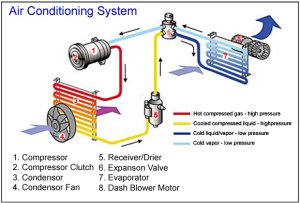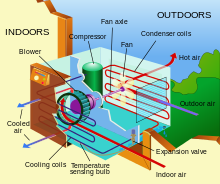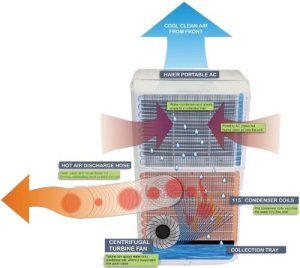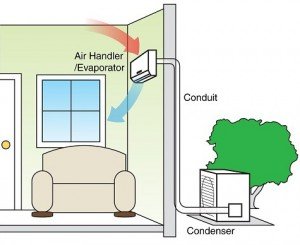No matter which type of unit you may have, air conditioner repairs are needed from time to time. The parts that will most often need repair are usually the same across units. This articles will discuss how air conditioning works, how parts are set up in window air conditioner, portable air conditioner and a ductless split system air conditioners. Finally, we will outline the parts that commonly need replacement.
How Air Conditioning Works
(by Mark Quasias of rvcruzer.com)
Air conditioning works by exchanging heat between two separate areas. It does this by compressing gas and then expanding it. When the gas expands it gets cooler and absorbs heat from the interior of the vehicle. When it is compressed it retains heat, which is transferred to the exterior of the vehicle. It does this by passing through a pair of heat exchangers, which are similar to radiators. The exchanger on the inside of the vehicle is called the evaporator because this is where the gas expands and cool air is blown into the compartment. The exterior unit is the condensor, so named because the gas is condensed after it leaves the compressor. This is where the heat is removed from the refrigerant by the condensor fan, which blows it into the atmosphere.
An engine driven compressor pumps the cold low pressure vapor and compresses it into hot high pressure gas. As this gas passes through the condensor the condensor fan blows the heat away into the atmosphere, cooling the refrigerant into a cool liquid form. It then passes through a receiver/drier, which ensures that there is no moisture in the system that could cause any freeze ups in the lines, and then enters the expansion valve. The expansion valve is a small orifice that allows the refrigerant to expand to a gas form as it passes through. The cool liquid refrigerant will convert to a cold gas. As it passes through the evaporator it picks up the heat from the air that the evaporator fan is passing through the core giving you nice cold air as it’s output. It then returns to the compressor pump and begins it’s cycle all over again.
Air conditioning systems have their limits. Each unit is designed for a given temperature drop in degrees. A typical system is designed to cool up to 20 degrees. The temperature differential (also known as Delta T) between the condensor’s intake air and the evaporator’s output air will be 20 degrees and no more. So, if you have 100 degree air entering your system the output temperature will never be any lower than 80 degrees. As the intake air cools down the output air temperature will also be lowered so the cooling will improve the longer it runs. They key is to start it early enough before the temperatures get too extreme.
Humidity also pays a factor. Humid air is dehumidified as it passes through the evaporator core. This condensate will run down the roof or be pumped out via drain tubes. But the process of making this condensate does steal some of the ability to lower the output air temperature so your Delta T may drop to 16-18 degrees rather than 20, depending on just how humid it is. Therefore your air conditioner will perform better in drier climates than in humid areas. The main thing to remember is that your unit won’t cool as well in seriously hotter temperatures than it will in milder temperatures.
Each system requires a certain amount of refrigerant in order to function. If the unit is low on refrigerant it won’t perform as designed. Each system has a certain volume to it and requires a proportionate amount of Freon. An RV has a large condensor and long hose lengths that connect the evaporator in the front of the motorhome to the rear radiator area where the condensor is found. Therefore a 40′ motorhome will require more refrigerant than a compact car. Adding extra refrigerant above and beyond the specified amount will not improve your air conditioner’s performance. In fact, it will be detrimental to it and cause higher head pressures that will result in compressor failures.
Air Conditioner Parts by Type of Air Conditioner
For window air conditioner parts, let’s begin with the inner components. The evaporator coil converts the refrigerant liquid into gas that absorbs heat and humidity from the air. This heated gas is then carried outside through a tube called the condenser coil. The fan is responsible for blowing the cooled air into the room. There’s also the thermostat which determines the room temperature. The filter keeps most solid components from entering the coils.
A panel separates the inner and outer components. The outside components include the condensing coil, the compressor and the condensing fan. For more details, visit our article Window Air Conditioner Installation.
For a portable air conditioner parts, they are similar to window air conditioners but are configured differently. The main difference is that rather than part of the unit being outside as in window air conditioners, all cooling components are housed withing the unit. The vent hose carries the hot air out of the room to the outside. For more details, visit our article Portable Air Conditioner Installation.
For a ductless or spit system air conditioner, the cooling mechanism is split into two units. The outside condenser delivers refrigerant to the inside air handler which blows air over the coils to either cool or heat the room. For more details on portable air conditioners, please visit our article Wall Mounted Air Conditioner Installation.
Home air conditioner parts that need replaced most often are:
- Air Filter
- Refrigerant
- Thermostat
- Transformer
- Breaker
- Wire
- Condenser Fan
There are also parts specific to each type of air conditioner that may need replaced as well. The good news is that home air conditioner parts can be purchased at most hardware stores or online sellers such as Amazon. Most repairs for the units we have talked about can be done at home. However, if the repairs are more extensive, you will need to call a professional to service the air conditioner.



